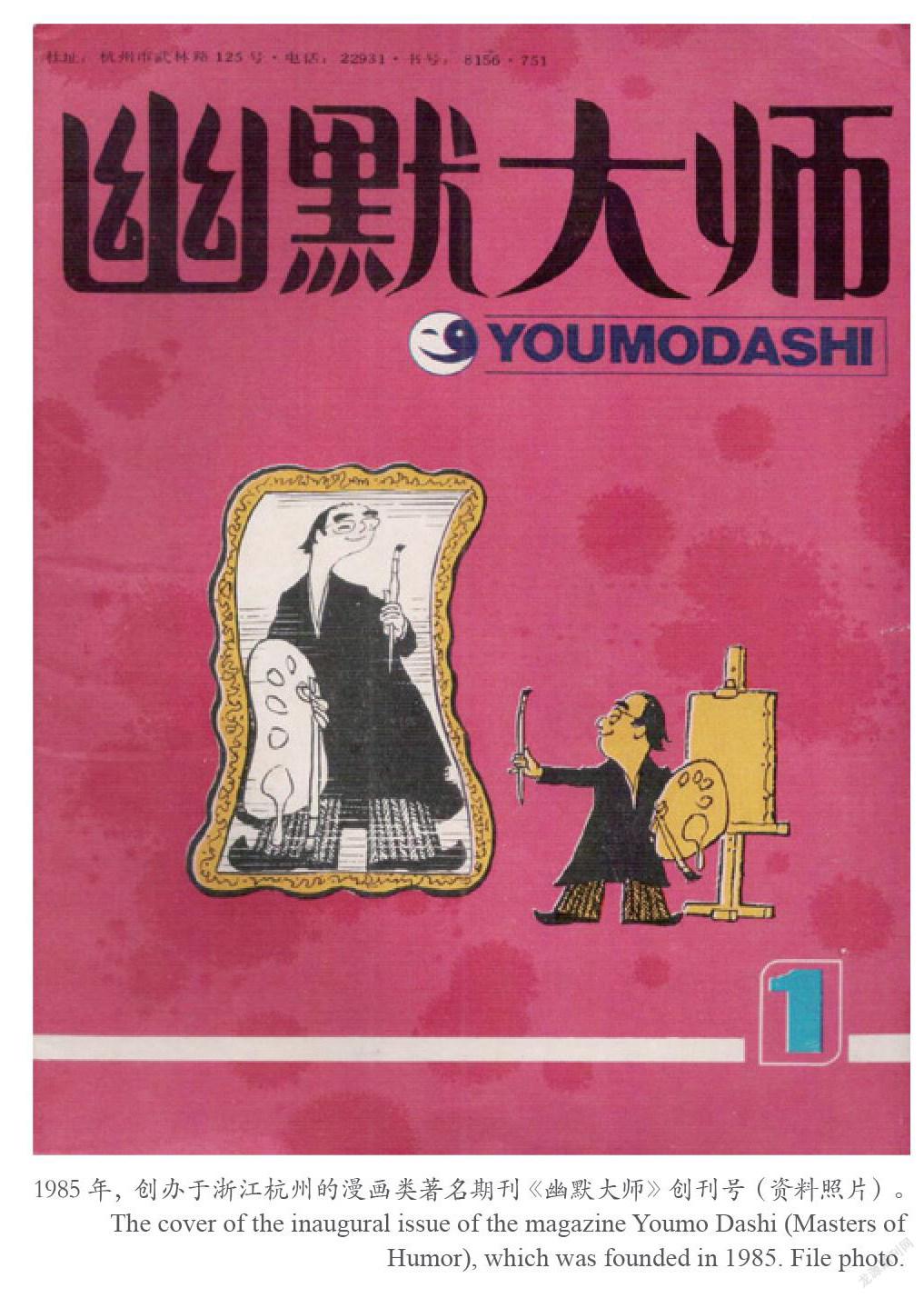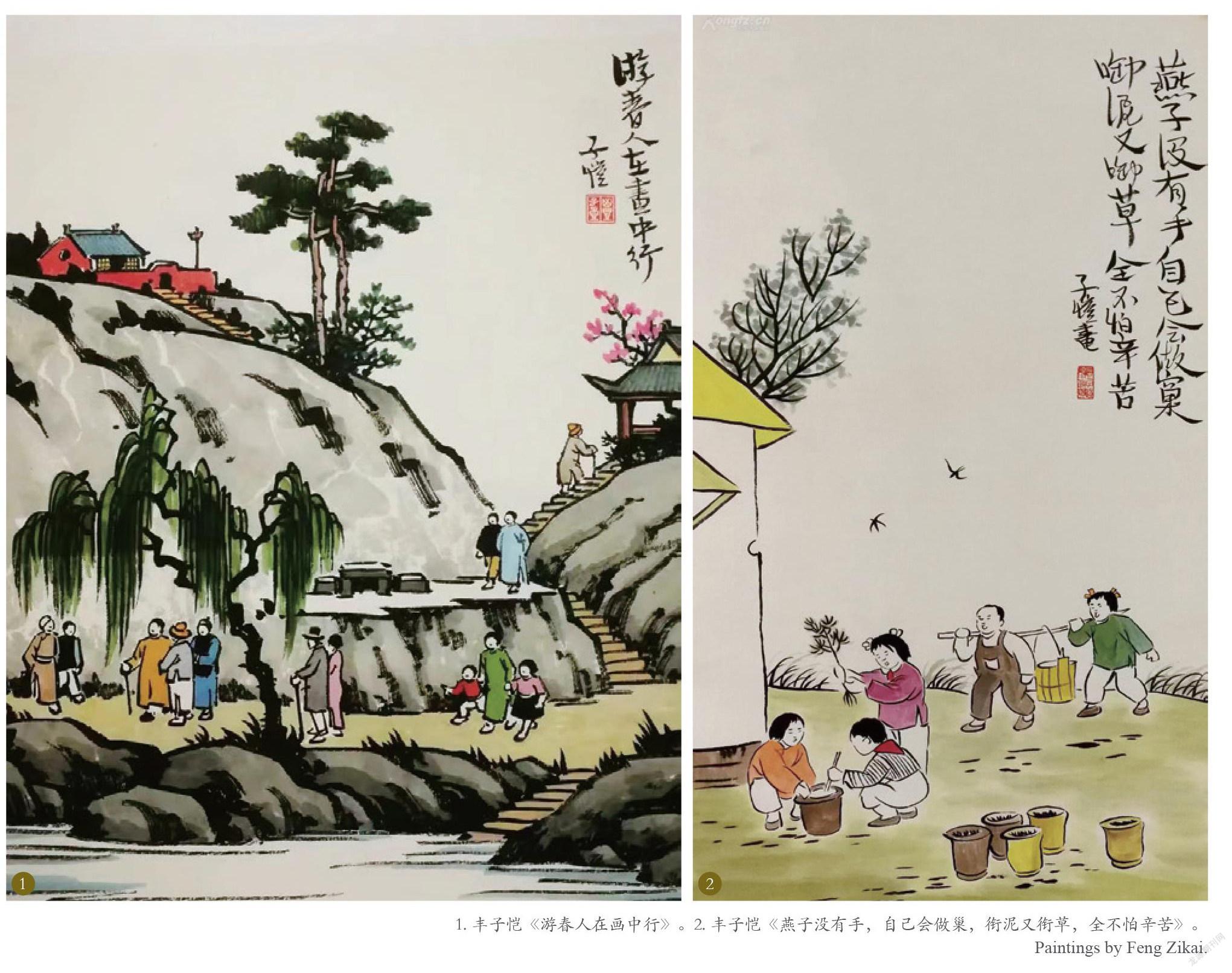中国近代漫画发展的摇篮和高地
时间:2023-10-26 09:05:17 来源:小苹果范文网 本文已影响 人 
周晔



“漫画”一词,最早出自北宋晁以道《景迂生集》中的“黄河多淘河之属,有曰漫画者,常以觜画水求鱼”。当时的“漫画”是指一种鸟类。近代意义的“漫画”概念,据漫画史家毕克官考证,出现于1904年《新民日报》的“时事漫画”栏目。而真正使“漫画”名称广泛流传的是1926年出版的《子恺漫画》。
中国的漫画主要分为两类:一类是从清末发展至今的传统漫画,主要是指运用夸张、比拟、象征等手法来描绘、反映、突出时事政治或生活现象的一种绘画形式,具有讽刺性和幽默性特点,篇幅短小精炼;一类是改革开放后受日式和美式漫画风格影响而产生的现代漫画,多采用分镜头方式展现一个完整故事,主题广泛,内容丰富。
纵覽中国漫画史,可以发现,近代浙江漫画家大师云集,群星闪耀,如钱病鹤、张聿光、沈泊尘、叶浅予、丰子恺、张乐平、华君武,以及近代以“牛鼻子”系列红极一时的民国三大漫画家之一嘉善人黄尧,近代首创年轻人大学漫画学院的漫画界伯乐海宁人米谷,等等。这些出生于1840至1919年的近代浙江漫画前辈所作出的开创性实践,几乎涵盖了中国漫画发展的基本要素。可以说,浙江是当之无愧的中国近代漫画发展的摇篮和高地之一,为中国近代漫画的发展打下了良好基础。通过回溯这些浙江漫画家的经历和成就,不难发现,近代浙江漫画发展有一些鲜明的特点。
屡开漫画界先河
生于湖州南浔的钱病鹤(1879—1944年),1908年起历任《时事报》《神州日报》《民呼报》《民立画报》《民权画报》等的图画主笔。曾加入同盟会。初作漫画只是偶尔尝试,不料一纸风行,受到外界鼓励开始专业创作。1913年创作长达120幅组画的《老猿百态》(又名《猿政府外史》),矛头直指袁世凯,险遭拘捕。此后,又发表大量抨击军阀的作品,结集出版有《病鹤画丛》《病鹤新画》,成为清末民初的杰出漫画家之一,被称为中国时政漫画的“奠基人”。
张聿光(1885—1968年),生于绍兴山阴,最初以笔名“冶”在上海《新闻报》发表漫画,其中包括产生广泛影响的《袁世凯骑木马》《饭桶》等,是中国最早在报纸上发表政治讽刺画的漫画家之一,被尊称为讽刺漫画的“祖师爷”。
再比如,首份漫画期刊的创办者沈泊尘。沈泊尘(1889—1920年),生于桐乡乌镇,多才多艺,国画、油画、水彩画俱佳,作品高产。曾到上海南京路上的一家绸布庄做执业,其间拜“海上画派”的代表人物钱慧安为师,学习中国传统人物画。所创作的《新新百美图》和戏曲人物画名噪一时,其“沈氏现代仕女画”开一代新风。与胞弟沈学仁一起,于1918年9月创办了中国第一份漫画期刊《上海泼克》(又名《泊尘滑稽画报》),首开中国漫画刊物先河,标志着中国漫画进入一个崭新时期。著名才子陈定山说 :“上海报纸之有漫画,始于沈泊尘。若黄文农、叶浅予、张光宇正宇兄弟皆为后辈矣。”
沈泊尘的短暂一生,以积极的反抗、冷峻的讽刺、内心的激情和出色的艺术天赋,谱写了一位漫画家响亮的生命乐章,同时亦为中国近代漫画的发展打下了一块坚实的基石。
家喻户晓的桐乡之子丰子恺(1898—1975年),则被誉为“抒情漫画的开创者”。1914年,17岁的丰子恺只身赴杭州考取浙江省立第一师范学校,跟随李叔同等人学习。李叔同高尚人格品性和深厚艺术修养使他如沐春风,对他之后人生选择产生深刻影响。他在《为青年说弘一法师》中写道:“李先生喊我转来,又用很轻而严肃的声音和气地对我说 :‘你的图画进步很快。我在南京和杭州两处教课,没有见过像你这样进步快速的人。你以后可以……”短短几句话使他决定把一生奉献给艺术。
1925年5月,“子恺漫画”在郑振铎主编的《文学周报》上陆续发表。1926年1月,他出版第一本画集《子恺漫画》,“漫画”一词由此得以广泛传播。1936年起,他往来于杭州、桐乡石门和上海之间,在闲居生活中开启了他一生创作的黄金时代。后抗战爆发,他全家逃难。1949年10月回到上海,曾担任上海文史馆委员、上海市美术家协会副主席,1960年6月起任上海中国画院院长。他的画作多以儿童作为题材,幽默风趣,反映社会现象,被选入小学课文。他的漫画以“曲高需和众”的艺术主张和“小中能见大,弦外有余音”的艺术特色而备受人青睐。
“子恺漫画”追求一种崇高而绚烂的美,其中不乏哲思和诗意的存在,成为中国抒情漫画的一代宗师。
文化艺术造诣高,影响范围广
丰子恺是中国近代少有的“全才型艺术大师”。除绘画外,在文学、音乐、书法、艺术理论与翻译等方面都有重大贡献,在所涉及的艺术领域几乎都达到了巅峰。郁达夫认为,丰子恺的散文“清幽玄妙,灵达处反远出在他的画笔之上”。
张聿光早年曾在杭州生活三年,后到上海徐家汇土山湾画馆学习西洋美术。新中国成立后,曾任上海中国画院画师、中国美术家协会上海分会理事等。除漫画外,他还擅长舞台美术、国画艺术、商业设计,并从事美术教育,参与创办美术用品实业,是一位集画家、教育家、实业家于一身的杰出人才。晚年转向中国画创作,作品取材宽广,并能融汇中西画法,构图新颖,设色鲜净绚丽,饶有天趣,在国外也颇具影响,其作品被法国国立博物馆、德国柏林艺术院收藏。
被称为“连环漫画之巨擘”的叶浅予(1904—1995年),生于杭州桐庐。徐悲鸿曾对其国画作出评价:“浅予之国画如其速写人物,笔法轻快、动中肯綮。”“此在国画上如此高手,五百年来,仅有仇十洲、吴友如两人而已,故浅予之在艺术上之成就,诚非同小可也。”宗白华也评论说:“浅予的印度舞面,是古典美与现代美的结合。”
21岁时,叶浅予在上海《三晶画刊》发表处女作《两毛钱饱眼福》。第二年,他就与丁悚、张光宇等筹办中国第一个漫画团体“漫画会”,编辑出版大型漫画刊物《上海漫画》,从创刊号起发表长篇连环漫画《王先生》,成为中国漫画史上第一部鸿篇巨制,连载近10年之久。叶浅予作为中国长篇漫画的主要开创者,为中国连环漫画创作提供了宝贵经验并产生深远影响。1935年起,他探索开创了中国“速写漫画”造型艺术形式,成为美术界沿用至今的重要手法。642A58E5-3064-4D19-A70B-6FB06A400F49
1947年,徐悲鸿邀请其任教于国立北平艺专,致力于美术教育四十余載。晚年,他“画思渐稀文思寄,细叙沧桑记流年”,放下画笔,拿起文笔,写下了一生的回忆录。1988年,中国美术家协会漫画艺术委员会授予他“中国漫画金猴奖”荣誉。
张乐平(1910—1992年)是嘉兴海盐人,1926年参加“漫画会”,开始漫画创作。除漫画外,还涉猎年画、连环画、速写、素描、水彩画、剪纸、中国画等,造诣颇深,被列入“海内第一流名画家”。
1935年,张乐平创作了“三毛”漫画形象,引起广泛关注,被称为“三毛之父”,也被称为平民造像的“平民画家”。1936年,他与丰子恺、黄尧、华君武等人担任“首届全国漫画展览会”筹备会委员。展览于11月4日隆重开幕,是中国漫画史上第一次展览。
1936年,根据电影《小孤女》改编绘制,张乐平开创了将真人电影编绘成连环漫画的先例。1937年,他参与成立救亡漫画宣传队,任副领队。1946年,根据战斗中的见闻,创作了《三毛从军记》在《申报》连载发表,这是一部中国漫画史上具有划时代意义的作品。于次年创作的《三毛流浪记》被誉为“没有文字的文学巨作”,影响巨大,闻名于海内外。
中国台湾著名女作家陈平,因为幼时喜欢漫画《三毛流浪记》,就给自己取了个别名“三毛”,并以这个别名而闻名于世。法文版《三毛》获法国昂古莱姆国际漫画节大奖。比利时漫画博物馆也藏有“三毛”系列的出版物。张乐平被誉为中国最杰出的漫画家之一。
薪火相传,继往开来
华君武(1915—2010年),杭州人,13岁在浙江省立一中校刊发表第一幅漫画。之后,他连续向《浙江日报》的前身——《东南日报》投稿200多张漫画,结果只刊出一张,就是1931年创作的《江南可采莲,莲叶何田田》。这是他的作品第一次在报上发表,并且还赚得了一元大洋的稿费,“虽因扣税只得了九角多钱,但还是请了妹妹吃东西,高兴得很”。这张漫画发表不仅给他以极大信心,也让他知道了该如何创作。
1936年,华君武在上海被选为第一届全国漫画展览筹备委员,作品《男女平等》参展,在上海漫坛赢得了一席之地。1938年12月他到达延安,开始七年的“鲁艺”生活。1949年12月,奉调入京,任《人民日报》美术组组长,后改任文艺部主任。1953年,他又调到中国美协工作,直至1987年退休。
1979年1月20日,华君武与英韬等人共同推动,创办《讽刺与幽默》。该刊的出版是中国漫画史上一件大事,它见证了中国漫画中断10年后的重生,也标志着中国漫画迎来一个全新的历史阶段。他始终坚持走漫画大众化、民族化之路,成为改革开放后中国漫画界的“老大哥”。漫画家韩羽认为“华老的漫画中蕴涵着中国画最本质的东西”,即“书法结体入画”,华老的书法与他的画法一拍即合,“不仅‘互不排斥,而且直臻和谐之境”。他的这种集诗书画于一体的“华家样”,也成为中国漫画界的宝贵财富。
2005年,杭州举办首届中国国际动漫节。2006年,中国国际动漫节永久落户杭州,目前已经连续成功举办十七届,已成为中国最专业、最顶尖、最具引领性的动漫盛会之一。2021年,由中国国家广电总局和中国动画学会批准的“国字号”中国动漫博物馆建成开放。
赓续精神传统,传承文化基因,踔厉奋发,笃行不怠,浙江漫画、中国漫画事业正在不断取得新发展,实现新突破。
Zhejiang:
Manhuas Cradle and High Ground in Modern China
By Zhou Ye
The Chinese word “manhua” (comics or cartoons) first appeared in the Jingyu Sheng Ji written by Chao Shuozhi (1059-1129) in the Northern Song dynasty (960-1127). At that time, it referred to a certain kind of bird. The modern sense of manhua, according to the manhua historian Bi Keguan, was adopted by the “current affairs manhua” column of Xinmin Daily in 1904. Yet it was not until Zikais Manhua was published in 1925 that the usage of the word “manhua” became prevalent.
Chinese manhua is mainly divided into two categories:
one is traditional manhua developed from the late Qing dynasty (1616-1911) till today, which ironically and humorously depict and highlight current political or social phenomena through exaggeration, comparison, symbolism and other techniques, mostly short and concise; the other is modern manhua, which appeared after the Reform and Opening Up. Influenced by Japanese manga and American comics, the latter is mostly storyboard-based, rich in content, and good at telling the full story with a wide array of themes covered.642A58E5-3064-4D19-A70B-6FB06A400F49
Throughout the history of Chinese manhua, it can be found that the modern Zhejiang cartoonists are a collection of masters and stars, such as Qian Binghe, Zhang Yuguang, Shen Bochen, Ye Qianyu, Feng Zikai, Zhang Leping, Hua Junwu, Huang Yao and Mi Gu. Their pioneering practices in modern China covered almost all the elements of cartoon development. Therefore, Zhejiang fully deserves the title of a cradle and high ground for the development of modern Chinese manhua, for which it has already laid a good foundation. By tracing the experiences and achievements of these Zhejiang cartoonists, it is easy to find that there are some distinctive and outstanding characteristics of Zhejiangs manhua development in modern times.
Born in Nanxun, Huzhou, Qian Binghe (1879-1944) was one of the outstanding cartoonists in the late Qing dynasty and the early Republic of China and is honored as the founding father of Chinese current affairs manhua.
Zhang Yuguang (1885-1968) was born in Shangyin, Shaoxing and was one of the first cartoonists to publish political satire manhua in Chinese newspaper and is respected as the “grandfather” of satirical manhua.
Shen Bochen (1889-1920) was the founder of the first manhua periodical in China. Together with his brother Shen Xueren, he established China"s first manhua periodical Shanghai Puck in September 1918, which was the first cartoon publication in China and marked a brand-new period for Chinese manhua.
Feng Zikai (1898-1975), also known as the “Son of Tongxiang”, is regarded as the pioneer of humanistic manhua. In 1914, at the age of 17, he went to Hangzhou and enrolled in the Hangzhou High School, where he studied under Li Shutong (1880-1942). Li "s noble personality and profound artistic cultivation had a profound influence on Feng, who later determined to dedicate his entire life to art.
In May 1925, Feng"s works were published one after another in the Literary Weekly edited by Zheng Zhenduo (1898-1958), and in January 1926, he published his first collection of drawings, Zikai"s Manhua, and thus the usage of the term “manhua” was widely spread. From 1936 onward, he traveled between Hangzhou, Shimen and Shanghai, and ushered in the heyday of his artistic career. His cartoons, mostly with children as the subjects, are humorous and reflective of social phenomena, and have been selected for inclusion in elementary school textbooks. They are also very popular because they embrace the needs of the public and imply ultimate beauty through details.642A58E5-3064-4D19-A70B-6FB06A400F49
Feng Zikai is one of the rare “all-round masters” in modern China. In addition to painting, he made significant contributions to literature, music, calligraphy, art theory and translation, and reached the top of almost all the fields he covered.
Zhang Yuguang (1885-1968) lived in Hangzhou for three years when he was young, and then went to Shanghai to study Western art at the Tou-Se-We Art Studio. Besides cartoons, he was also good at stage art, Chinese painting art, commercial design, and engaged in art education and participated in the establishment of art supplies industry, an outstanding all-in-one talent.
Ye Qianyu (1904—1995) was born in Tonglu, hangzhou. As the major pioneer of Chinese long manhua, Ye provided valuable experience and had a profound impact on the creation of Chinese comic strips. From 1935 onwards, he explored and created the Chinese art form of “sketch manhua”, an important technique used in the art world to this day.
Zhang Leping (1910-1992) was a native of Haiyan, Jiaxing. He began to create cartoons in 1926, apart from which he also did annual paintings, comic strips, sketches, drawings, watercolor paintings, paper-cutting, etc. He had made great achievements and is honored as one of the greatest cartoonists in China.
In 1935, his “Sanmao the Orphan” comics debuted, which attracted widespread attention and he thus became known as “the father of Sanmao". In 1936, he served as a member of the preparatory committee of the First National Cartoon Exhibition with Feng Zikai, Hua Junwu and others. The exhibition was grandly opened on November 4, which was the first exhibition in the history of Chinese manhua. In the same year, he created the first comic strip based on the movie The Little Orphan Girl, and in 1937 he participated in a cartoonist troupe and served as the deputy leader. In 1946, based on what he saw during the battle, he created and published Sanmao Joins the Army, an epoch-making work in the history of Chinese cartoons. It was hailed, together with The Wandering Life of Sanmao created in the following year, as “literary masterpiece without words", which had a great impact around the world.
Hua Junwu (1915-2010), a native of Hangzhou, published his first cartoon at the age of 13 in the school magazine of Hangzhou High School. In 1936, he was elected as a preparatory committee member of the First National Cartoon Exhibition in Shanghai. On January 20, 1979, Hua, together with others, launched a journal titled Satire and Humor. The publication of the journal was a major event in the history of Chinese manhua, which witnessed manhuas rebirth after a 10-year standstill and marked its brand-new historical stage.
In 2005, Hangzhou held the first China International Animation Festival. In 2006, this annual festival permanently settled in Hangzhou, and has been successfully held for seventeen consecutive years. It has become one of the top animation events in the country. It is evident that the manhua industry in Zhejiang and in China are developing rapidly, achieving new breakthroughs.642A58E5-3064-4D19-A70B-6FB06A400F49
猜你喜欢 漫画家三毛漫画 我与《三毛流浪记》小学生作文·小学低年级适用(2022年4期)2022-04-27远方新作文·中学作文教学研究(2018年11期)2018-12-13呆呆和朵朵(24)故事作文·低年级(2016年12期)2016-12-15呆呆和朵朵(23)故事作文·低年级(2016年11期)2016-11-29知识漫画百科知识(2016年18期)2016-10-28漫画4幅妇女生活(2016年10期)2016-10-12漫画与幽默读者(2016年20期)2016-10-09娓娓道来的真诚小学生·新读写(2014年2期)2014-03-20三毛流浪记早期教育(家庭教育)(2009年6期)2009-06-19
